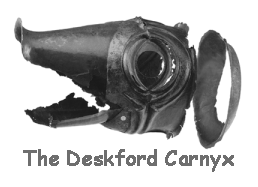 From John Hooker's "Trumpets as serpents/dragons"
From John Hooker's "Trumpets as serpents/dragons"
Anyone who has ever searched on the Internet for information about the Dubno family has no doubt encountered a number of interesting pages that mention our name. There is a town in the Ukraine that is named Dubno, but our family didn't come from there - we came from Plonsk. It is quite possible that many years ago we did come from Dubno, it is also quite possible that we are decendant from the famous Maggid of Dubno, and it is also quite possible that we arrived on a UFO.
In the 1948 Yitzchak Yoav Dubno died in the Battle of Negba. Kibutz Givat Yoav is named after him. The Dubno family name is gone in Israel because there were only female heirs. His daughter may have been wounded in Yaad Mordechai. Israel's famous singer Arik Einstein's mother was a Dubno.
The are two towns named Dubno and one named Dubna. The first, and better known, is in the Ukraine;
the second, is in the Czech Republic and the third is in Russia. Here are some interesting links -
Wikipedia,
Ukraine Map,
Czech Republic,
Dubna Russia
As far as we know, the Dubno family doesn't come from a Gaelic or Celtic background. However, "dubno" meant something a long time ago to the Gaelic and Celtic people.
 From John Hooker's "Trumpets as serpents/dragons"
From John Hooker's "Trumpets as serpents/dragons"
Actually the carnyx depicts a boar. The Deskford carnyx (Scotland) shows this very clearly, and the carnyces on the Gundestrup cauldron show what might appear as horns, but are really the cropped ears of the animal. On the latter the boars crests are very clear, as are the snouts. The symbolism of the boar is that of the underworld or the "deep" -- "dubno" in Celtic. A problem in the interpretation of this animal was that everyone from Derek Allen down has only seen the boar in the light of "boar standards" from Roman bas-reliefs and have leapt to the assumption that the animal symbolized war. The boar (and indeed the pig generally) is universally understood as a symbol of the underworld, when he is combined with solar imagery as in many Celtic coins, he refers to the passage of the seasons, and the constant battle between the hero and the boar, is the same as the cycle of the dark and light times of the year. The assumed names of Celtic chieftains often reflect the underworld element as in Dubnovellaunos "the warrior from the deep". More...
From About.com:Genealogy
Donaldson is a Scottish and Irish Patronymic name form of the surname Donald that comes from the given name Domhnall and is comprised of the Gaelic elements dubno = world + val = might, rule. Variants are Donnell, Doull, Doole , and patronymic versions include Donaldson, McDonald, McConnell, O'Donnell, O'Donill, and O'Daniel (when derived from Gaelic O'Domhnaill ). More...
From MacBain's Dictionary
Domhan - The Universe, so Irish, Old Irish domun, Gaulish Dubno-, Dumno- (in many proper names, as Dubnotalus, Dumnorix, "World-king", Gaelic Domhnall, *Dumno-valo-s, Welsh Dyfnual, Celtic *dubno-, the world, the "deep"; another form of domhain above. Cf. English deep for the "sea". D'Arbois de Jubainville explains Dubno- of Gaulish names as "deep", Dumnorix, "deep king", "high king"; and he has similarly to explain Biturix as "king for aye", not "world king": all which seems a little forced. More...
From Clan Farquharson
McConnell is a Scottish patronymic name, Anglicized from the Gaelic Mac Dhomhnuill , which meant "son of Domhnall" whose name came from Celtic elements dubno = world + val = might, rule. When the name is of known Irish origin, it is taken from the Anglicized form of the Gaelic name Mac Conaill , meaning "son of Conall" whose name was taken from Celtic elements con, cu = hound + gal = valor. Variations include MacConnel, McConnal . Whannell and McWhannell are Scottish variations. More...
 From "The Sustainable Village"
From "The Sustainable Village"
Dubno Oil Primer - Outdoor Oil Primer
Use it on any wood surface that faces the elements, like decks, shingles, shutters, sheds, sandboxes, and more. An essential foundation for all of Livos oudoor products, it offers deep elastic penetration that protect while wood ages to that silvery patina. More...
The town of Dubno in the Ukraine is known as "The Oak City," so having a wood primer with the Dubno name seems to make some sense.
 From "National Investigations Committee
On Aerial Phenomena"
From "National Investigations Committee
On Aerial Phenomena"
On June 21, 1983 a UFO was sighted over the Dubno Nuclear facility in the Ukraine. Coordinates 25.44.0 East, 50.24.0 North. It was visible for about 18 minutes.
#13365: 1983/6/21 0:0 18 25:44:0E 50:24:0N 3331 EEU UKR LVV 7 9 DUBNO,UKRAINE:WINGLESS CGR CCLS STRATEGIC NUCLEAR FACILITY/18min:NFD Ref# 195 FLYING SAUCER REVIEW: (London) Volume 37 Issue 4 MIL. BASEMore...
(Of course, our family may have something to do with the UFO...)
From Wikipedia
In the Battle of Brody (1941) the German 1st Panzer Group under Ewald von Kleist managed to break the counter-attack by Soviet 9th and 19th Mechanized Corps, and 8th Mechanized Corps. 8 th Corps Tank Group take Dubno and held him 5 days before is turn back by stronger German forces' (under Konstantin Rokossovski, Nikolay Feklenko and D.I Rybjasev, Commander of 8th Corps Tank group was brigade commisar N.K. Popel, respectively).
Soon afterwards the town was occupied by Germany. In 1942 a large ghetto was created there. Most of the local Jews (roughly 12,000, that is 59% of pre-war inhabitants of the town) were killed in The Holocaust. Most were shot at mass executions by the SS Einsatzgruppe outside town. A detailed description of the mass murder was given by Hermann Friedrich Graebe at the Nuremberg trials. A young German officer of the German Infanterieregiment 9, Axel von dem Bussche witnessed the executions and reacted by joining the resistance movement against Hitler. After the war the town was given to Soviet Ukraine.
 From "Warriors of the Silver Screen"
From "Warriors of the Silver Screen"
Franz Waxman's 1962 score for Taras Bulba suffers from an acute case of the Bolsheviks, but in this case this is not quite as bad as it sounds, because its obvious Cossack influence to the music gives it a perfect ethnic flavour: there are lots of spinning, surging violins in the opening 'Overture', while 'The Birth of Andrei' is a soft, delicate theme with a soothing oboe underscore, and the incredible 'The Ride to Dubno' has a marvellous, vibrant percussion beat and conjures up images of men flying across the grassy steppes in search of battle.
Underworld - Dubnobasswithmyheadman From "Amazon"
Underworld's electronica 1994 debut, Dubnobasswithmyheadman, is still regarded by many as one of the best techno/electronica CDs of all time. Check it out at Amazon.
The family even has an atomic element named after it! Atomic element number 105 - Dubnium. This is how we figured it - Albert Einstein was really smart and knew a lot about the atom and stuff - he has element number 99. We have the last name "Dubno" which sounds a lot like "Dubna," where a lot of nuclear research occured. We want to be smart too, so we decided that Dubnium is named after us! In fact, the town of Dubno - which also has a strategic nuclear facility, is hundreds of miles away from the city of Dubna - which is right outside of Moscow.
From the Joint Institute for Nuclear Research -
Dubna - town of science - As a town of science, Dubna dates from the time immediately after the end of World War II. In 1947 a group of scientists led by Academician I. V. Kurchatov initiated construction of the then largest accelerator of charged particles - synchrocyclotron - on the bank of the Volga river, 120 km from Moscow. The accelerator was commissioned already in 1949. More...Learn more about Dubnium.
From "Encyclopedia Judaica" -
City in Volhynia, Ukraine. Dubno had one of the oldest, and for four centuries, most important Jewish communities in Eastern Europe. Jews in Dubno are first mentioned in documents of 1532 in connection with the ownership of cattle. The oldest tombstone inscription in the Jewish cemetery dates from 1581. At the beginning of the 17th century Isaiah ha-Levi Horowitz, author of Shenei Luhot ha-Brit was rabbi in Dubno. The community was represented on the council of the province of Volhynia. The Jewish community was reestablished shortly after the Chmielnicki massacres, and by the beginning of the 18th century Dubno had become the largest Jewish community in the district of Luck, and earning the name of "Dubno the Great." The great fair of Lvov was moved to Dubno between 1773 and 1793, and the city became an important commercial center. The most famous of the 18th century Jewish preachers was known as the Maggid of Dubno, after the city with which he was most closely associated. During World War l and the civil war in Russia, the city changed hands a number of times and the community suffered extreme hardship. While Dubno belonged to Poland (1921 - 1939), the community maintained many cultural institutions and there was an active Zionist and pioneer movement.
The Maggid of Dubno -
"When the Gaon of Vilna, the great rabbi Elijah ben Solomon Zalman fell ill and was too weak to study, he asked the Dubno maggid to visit him and read him his stories, parables and biblical interpretations. Once the maggid was asked, "How is it that for every moral lesson you have a beautiful story to teach it with?" The maggid smiled. "To answer that I can tell another story. I was once walking in the woods and saw a boy shooting arrows at targets. There were targets on every tree and each one had an arrow dead center. 'How expert you are!' I said. 'How did you manage so many exactly at the bull's-eye?' 'It's easy,' the boy answered. 'First I shoot the arrow and then I draw the target around it.' I do the same," said the maggid."There are many references to the Maggid of Dubno on the Internet, but no definitive site. There is a book - "Maggid of Dubno and his Parables" which I think is still in print. Since Maggid is a title - and not a name, the real name of the Maggid was Rabbi Yaakov Kranz or Jacob Kranz.